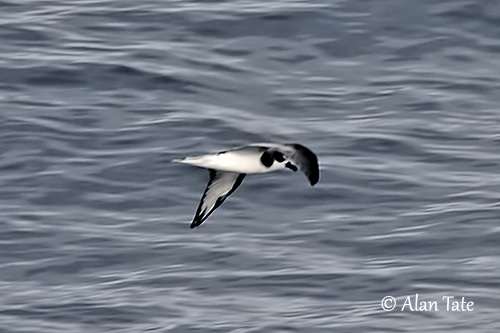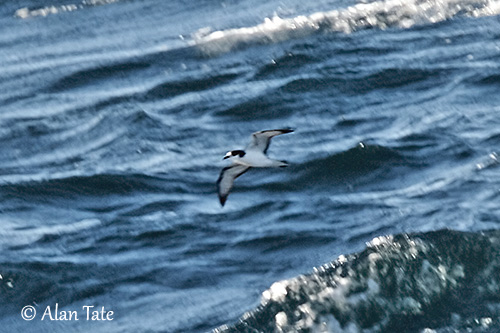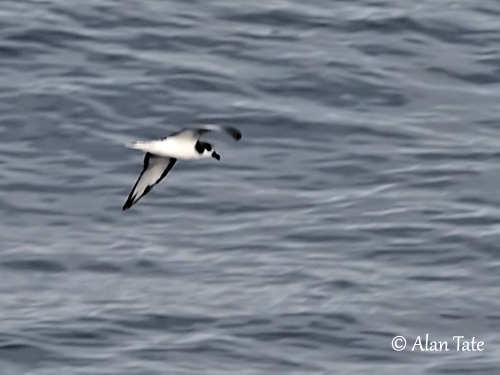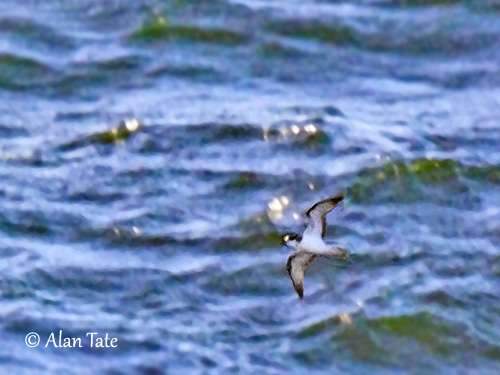
PROTECTION / THREATS / STATUS:
The Stejneger's Petrel is heavily affected by predation on breeding colonies by feral cats, Brown Rats and House Mice, involving population decline.
The feral cats prey on near-fledging chicks, while they are preparing their departure from the burrow.
Rodents and cattle degrade the habitat by eating fruits and seeds, causing also defoliation and soil erosion.
In addition, the Stejneger's Petrel has a restricted range. It is also vulnerable to climate change and extreme weather events.
The population was roughly estimated at 131,000 pairs in 1992, but more recent estimates suggest that the numbers may be lower (2003-2004). The population is declining due to predation.
The Stejneger's Petrel is currently classified as Vulnerable.
Fr: Pétrel de Stejneger
Ang: Stejneger's Petrel
All: Stejnegersturmvogel
Esp: Petrel de Más Afuera
Ita: Petrello di Stejneger
Nd: Stejnegers Stormvogel
Sd: Stejnegers petrell
Photographers:
Alan & Ann Tate
AA Bird Photography
Text by Nicole Bouglouan
Sources:
HANDBOOK OF THE BIRDS OF THE WORLD vol 1 by Josep del Hoyo-Andrew Elliot-Jordi Sargatal - Lynx Edicions - ISBN: 8487334105
Petrels, Albatrosses, and Storm-Petrels of North America: A Photographic Guide De Steve N. G. Howell – Editor: Princeton University Press, 2012 – ISBN: 0691142114, 9780691142111 – 482pages
OISEAUX DE MER – Guide d’identification de Peter Harrison – Editions Broquet (Canada) – ISBN-10 : 2890004090 – ISBN-13 : 978-2890004092
Oceanic Birds of the World: A Photo Guide De Steve N. G. Howell, Kirk Zufelt – Editeur: Princeton University Press, 2019 – ISBN: 0691197016, 9780691197012 – 360 pages
Birds of Melanesia: Bismarcks, Solomons, Vanuatu and New Caledonia De Guy Dutson – Editeur: Bloomsbury Publishing, 2011 – ISBN: 1408152460, 9781408152461 – 448 pages
Endemic breeding birds of Juan Fernández archipelago, Chile
NEST SITE USE IN SYMPATRIC PETRELS OF THE JUAN FERNÁNDEZ ARCHIPELAGO, CHILE: JUAN FERNÁNDEZ PETREL (PTERODROMA EXTERNA) AND STEJNEGER’S PETREL (PTERODROMA LONGIROSTRIS)
Page family Procellariidae
Summary cards
Stejneger's Petrel
Pterodroma longirostris
Procellariiformes Order – Procellariidae Family
INTRODUCTION:
The Stejneger's Petrel breeds in the Juan Fernández Islands and spends the winter in NW Pacific Ocean. As usual, the species is marine and pelagic outside of breeding season.
It breeds on oceanic islands, on slopes and ridges in dense fern forest. It nests in excavated burrow and both parents share the nesting duties.
The Stejneger's Petrel feeds on squid and small fish, and occasionally takes some insects, especially Hydrobates.
Following the breeding season, they migrate NW across the Pacific Ocean towards the wintering grounds in subtropical NW Pacific, off Japan.
The Stejneger's Petrel is strongly affected by predation by feral cats, introduced Brown rats and House Mice, involving population decline. In addition, this species has a very restricted range. It is currently listed as Vulnerable.
DESCRIPTION OF THE BIRD:
Biometrics:
Length: 26-31 cm
Wingspan: 70-76 cm
Weight: 114-167 g
The Stejneger's Petrel is a small, thin gadfly-petrel with narrow wings and medium-length tail.
The upperparts are pale grey with a conspicuous darker M pattern across upperwing and rump. The tail is slate-grey with darker central rectrices, especially at tip. The outermost pairs of feathers are paler grey.
The underparts are mainly off-white. On the white underwing, we can see a thin, usually broken blackish carpal bar, and narrow, blackish leading and trailing edges. The wingtip is blackish too.

On the head, crown, nape and neck sides are medium to dark grey. The eyes are surrounded by blackish shadows. The white forehead extends onto the forecrown, above the front of the eye. A broad area on sides and rear of neck is dark slate-grey, often slightly paler than the crown. Chin and throat are white.
The bill is black. The eyes are dark brown. Legs and toes are blue admixed pinkish-flesh or greyish. The webs are duller, washed pinkish to brownish-flesh.
Male and female are similar.
The juvenile resembles adult, but mantle and scapulars show a faint, scaly appearance due to narrow, pale grey fringes.
RANGE:
The Stejneger's Petrel is found in the Pacific Ocean. It breeds only on Alejandro Selkirk Island (formerly Más Afuera Island) in Juan Fernández Islands, 850 km W of Valparaiso, Chile.
During the non-breeding period, most of the population appears to spend June through September far offshore in the NW Pacific Ocean, in the Oyashio-Kuroshio Extension Current, SE of Japan.
HABITAT:
The colonies of the Stejneger's Petrel are established in dense fern forest (Dicksonia), between 850 and 1,100 metres of elevation on steep, rugged mountain sides.
It spends the non-breeding season at sea and is highly pelagic.

CALLS AND SONGS: SOUNDS BY XENO-CANTO
The Stejneger's Petrel is usually silent at sea, but while flying over the colony, it gives a rapid “ti-ti-ti” similar to other small Pterodroma species.
BEHAVIOUR IN THE WILD:
The Stejneger's Petrel feeds mainly on squid and small fish. It may occasionally take sea skaters (Hydrobates) and other insects.
In the eastern tropical Pacific Ocean, the diet is highly varied, but the bird has more or less the same diet all year round.
It feeds primarily on fish (60%), but it also takes myctophids (lantern fish) coming to the surface at night. Jellyfish is also part of the diet.
It usually forages solitary and by night.
The Stejneger's Petrel breeds in mixed-species colonies, and especially with the Juan Fernandez Petrel. However, within the colonies, the Stejneger's Petrel forms monospecific clusters.
Herbaceous perennial grassland with good accessibility is the most suitable habitat for this petrel. It nests in burrow excavated by the male, using both bill and feet.
The breeding behaviour of this species is poorly known.

The Stejneger's Petrel moves from Chilean waters in April and May, departing roughly W-NW through Polynesia, passing S of Hawaii. But when returning to the breeding grounds in September and October, it passes though Hawaiian waters before turning south.
They migrate 16,000 km NW across the Pacific Ocean towards the wintering grounds in subtropical NW Pacific, off Japan. They often forage in the cold waters of the Oyashio-Kuroshio Extension Current flowing E from Japan to Hawaii.
The Stejneger's Petrel is a very rare migrant to the east, offshore in California and Oregon.
The flight is similar to other small gadfly petrels, flying slightly in wide arcs above the sea.
It may accompany ships for long distances.
REPRODUCTION OF THIS SPECIES:
The breeding season takes place from November to May on Alejandro Selkirk Island (Más Afuera Island). This island is the more distant of the two main Juan Fernández Islands.
The Stejneger's Petrel often breeds alongside the Juan Fernandez Petrel. It nests in excavated burrows on slopes, usually in well vegetated areas such as fern-forest, fern-scrub and adjacent meadows and ridges. It is usually found between 850 and 1,100 metres of elevation on Cerro de los Inocentes. The egg-laying probably occurs in late December/early June.
The female lays a single white egg. The duration of the incubation is unknown, but both adults share this period in shifts of 14-21 days. From an observation, there was only one brooding changeover during this period.
At hatching, the chick is covered in grey down. From the same observation, the chick was brooded continuously from hatching between 28 and 31 January, until the night of 3 February when the parents departed. The chick has disappeared by 14 February.
